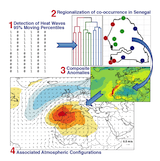l’article du mois – août 2019
 Heat wave occurrences over Senegal during spring: regionalization and synoptic patterns
Heat wave occurrences over Senegal during spring: regionalization and synoptic patterns
Sambou M-J G, S Janicot, B Pohl, D Badiane, AL Dieng & A Gaye
International Journal of Climatology, in press. https://doi.org/10.1002/joc.6220
Based on twelve Senegalese stations of the Global Summary of the Day (GSOD) database (1979‐2014), Heat Waves (HW) are defined for each station in spring (March‐April‐May, the hottest season in Senegal) as the daily maximum temperature (Tx), minimum temperature (Tn), or average apparent temperature of the day (AT), exceeding the corresponding 95% mobile percentile for at least three consecutive days.
A hierarchical cluster analysis used to regionalize HW in these 12 stations is applied to simultaneous occurrences of daily temperature peaks over their 95% mobile percentiles. Three homogeneous zones of 4 stations each are identified (Zone 1, Zone 2 and Zone 3), from west (Atlantic coastline) to east (inland Senegal). Atmospheric circulation associated with HW is assessed through composites of ERA‐Interim deseasonalized anomalies, with the start date of each HW in each zone used as a reference. The main pattern controlling the presence of HW in Senegal consists in positive pressure anomalies centered around the strait of Gibraltar, promoting easterly to northeasterly wind anomalies. This causes higher temperatures in the three zones of Senegal, and lower temperatures and drier air over the central Sahel. This pattern is opposite to that characteristic of HW in the Central Sahel shown in previous studies. From Zone 1 to Zone 3, the temperature and moisture patterns are shifted to the east while pressure anomalies weaken drastically. Nighttime Tn‐HW are characterized by higher water vapor contents than daytime Tx‐HW, corroborating and complementing previous studies over the Sahel. These HW patterns are close to the canonical mode of intra‐seasonal atmospheric variability over Senegal.
- extrait:
- lien_externe:
- kc_data:
- a:8:{i:0;s:0:"";s:4:"mode";s:0:"";s:3:"css";s:0:"";s:9:"max_width";s:0:"";s:7:"classes";s:0:"";s:9:"thumbnail";s:0:"";s:9:"collapsed";s:0:"";s:9:"optimized";s:0:"";}
- kc_raw_content:
 Heat wave occurrences over Senegal during spring: regionalization and synoptic patterns
Heat wave occurrences over Senegal during spring: regionalization and synoptic patternsSambou M-J G, S Janicot, B Pohl, D Badiane, AL Dieng & A Gaye
International Journal of Climatology, in press. https://doi.org/10.1002/joc.6220
Based on twelve Senegalese stations of the Global Summary of the Day (GSOD) database (1979‐2014), Heat Waves (HW) are defined for each station in spring (March‐April‐May, the hottest season in Senegal) as the daily maximum temperature (Tx), minimum temperature (Tn), or average apparent temperature of the day (AT), exceeding the corresponding 95% mobile percentile for at least three consecutive days.
A hierarchical cluster analysis used to regionalize HW in these 12 stations is applied to simultaneous occurrences of daily temperature peaks over their 95% mobile percentiles. Three homogeneous zones of 4 stations each are identified (Zone 1, Zone 2 and Zone 3), from west (Atlantic coastline) to east (inland Senegal). Atmospheric circulation associated with HW is assessed through composites of ERA‐Interim deseasonalized anomalies, with the start date of each HW in each zone used as a reference. The main pattern controlling the presence of HW in Senegal consists in positive pressure anomalies centered around the strait of Gibraltar, promoting easterly to northeasterly wind anomalies. This causes higher temperatures in the three zones of Senegal, and lower temperatures and drier air over the central Sahel. This pattern is opposite to that characteristic of HW in the Central Sahel shown in previous studies. From Zone 1 to Zone 3, the temperature and moisture patterns are shifted to the east while pressure anomalies weaken drastically. Nighttime Tn‐HW are characterized by higher water vapor contents than daytime Tx‐HW, corroborating and complementing previous studies over the Sahel. These HW patterns are close to the canonical mode of intra‐seasonal atmospheric variability over Senegal.
